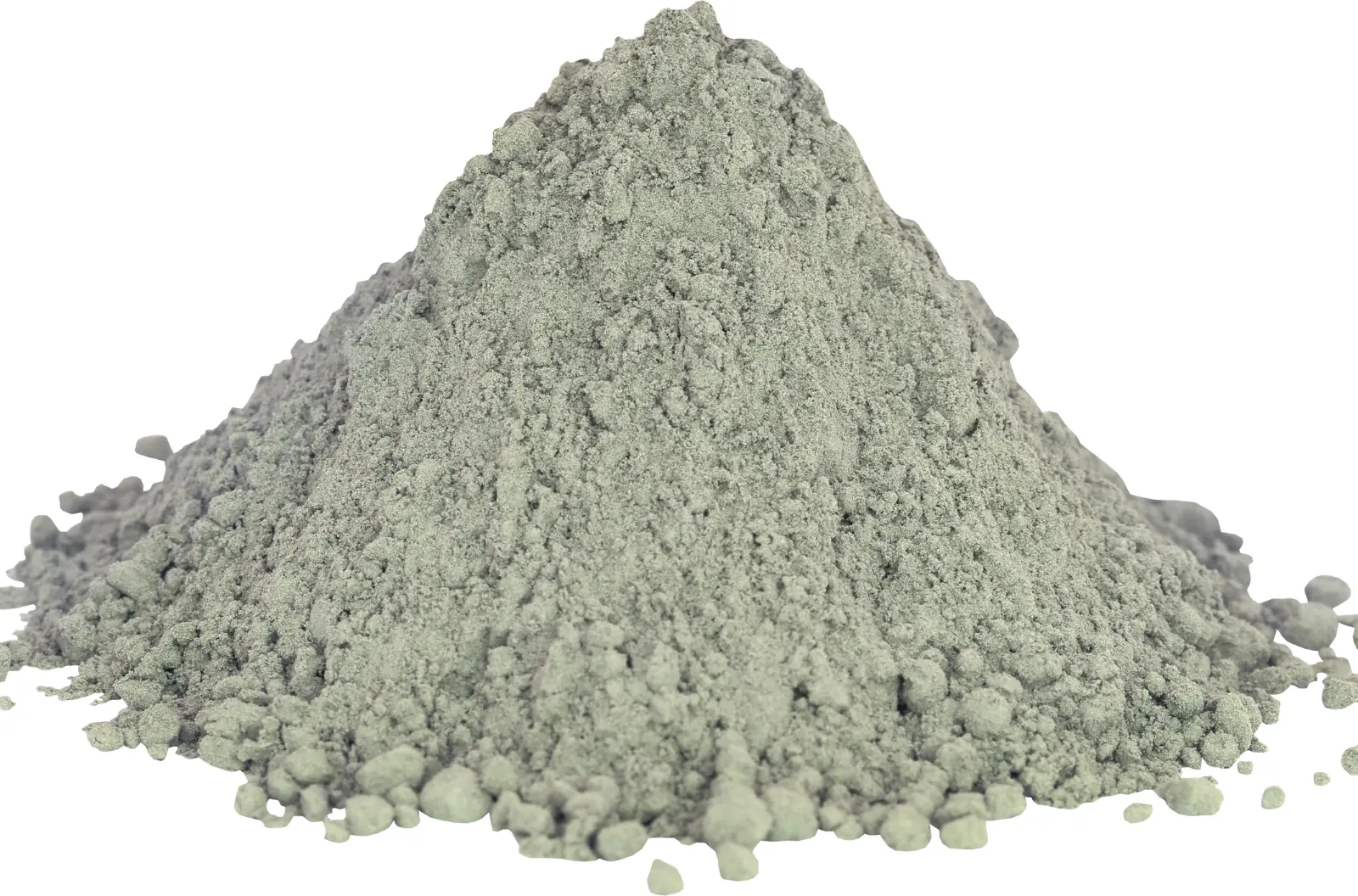Silica fume is primarily valued for its ability to enhance the properties of concrete, such as increasing strength, reducing permeability, and improving durability. When added to concrete, it reacts with calcium hydroxide to form additional calcium silicate hydrate (C-S-H), which fills in the gaps between cement particles, resulting in a denser and more robust concrete structure. Its use is particularly important in projects requiring high-performance concrete, such as bridges, tunnels, and industrial floors.
Silica fume has several distinct properties that make it an essential material in the construction industry, particularly for enhancing concrete performance. Below, we break down these properties into key categories:
Ultra-Fine Particles:Silica fume consists of extremely fine particles, typically less than 1 micron in diameter. This is about 100 times smaller than the average cement particle.
High Surface Area:The fine particle size results in a very high surface area, around 20,000 m²/kg, which is crucial for its reactivity in concrete mixes.
Reactivity:Silica fume is highly pozzolanic, meaning it reacts with calcium hydroxide in concrete to form additional calcium silicate hydrate (C-S-H), which is essential for strengthening the concrete.
Enhanced Durability:This reaction significantly improves the durability of concrete by reducing permeability and increasing resistance to chemicals like sulfates and chlorides.
Undensified Form:Silica fume in its undensified form has a bulk density ranging from 130 to 430 kg/m³.
Densified Form:When densified, its bulk density increases to between 480 and 720 kg/m³, making it easier to handle and incorporate into concrete mixes.
Standard Color:Silica fume is typically dark gray or black, depending on the production process.
Increased Water Demand:Due to its high surface area, silica fume increases the water demand in concrete mixes, requiring adjustments to the water-cement ratio.
Use of Superplasticizers:To maintain workability, superplasticizers are often used alongside silica fume.
Silica fume’s unique properties, such as its ultra-fine particle size, high pozzolanic activity, and variable bulk density, make it a powerful additive for improving concrete’s strength, durability, and performance. Whether used in its standard form or as white silica fume, it offers substantial benefits across a range of applications.
Silica fume is primarily composed of silicon dioxide (SiO₂) in an amorphous, non-crystalline form. Its chemical properties play a crucial role in its effectiveness as a pozzolanic material, particularly in concrete applications. Here’s a breakdown of the key chemical properties:
Composition:Silica fume typically contains more than 85% silicon dioxide (SiO₂), which is the primary component responsible for its reactivity in concrete. The high SiO₂ content is what makes silica fume an effective pozzolan, allowing it to react with calcium hydroxide in cement to form additional calcium silicate hydrate (C-S-H).
Non-Crystalline Form:Unlike crystalline silica, such as quartz, silica fume is amorphous, meaning it lacks a defined crystalline structure. This amorphous nature increases its reactivity in concrete, as it is more readily available to participate in chemical reactions during the hydration process.
Reaction with Calcium Hydroxide:When mixed with water and cement, silica fume reacts with calcium hydroxide (Ca(OH)₂), a by-product of cement hydration. This reaction produces additional C-S-H, which is responsible for the strength and durability of concrete.
Reduction of Free Lime:The pozzolanic reaction also reduces the amount of free lime (Ca(OH)₂) in the concrete, which can otherwise be susceptible to leaching and chemical attacks.
Purity:Silica fume generally has low levels of impurities, such as iron oxide (Fe₂O₃), aluminum oxide (Al₂O₃), and magnesium oxide (MgO). The low impurity levels contribute to the consistent performance of silica fume in concrete applications.
Alkaline Nature:Silica fume has a slightly alkaline pH, typically ranging from 9 to 10. This property helps it blend well with cement and other alkaline materials in concrete.
The chemical properties of silica fume, particularly its high silicon dioxide content, amorphous structure, and strong pozzolanic reactivity, make it an essential additive for improving the strength, durability, and chemical resistance of concrete. Its low impurity levels and alkaline nature further enhance its performance, ensuring that it integrates seamlessly into concrete mixes.
Silica fume, a by-product of silicon and ferrosilicon alloy production, is available in various forms that cater to different construction needs. Understanding the different types of silica fume is crucial for selecting the right material for your specific project requirements. Here’s an overview of the main types:
Description:Undensified silica fume is the raw form of the material, consisting of ultra-fine particles with a low bulk density, typically around 130 to 430 kg/m³.
Applications:This type is highly reactive and is used in high-performance concrete where maximum pozzolanic activity is required. It’s ideal for projects demanding superior strength and durability, such as bridges, high-rise buildings, and industrial floors.
Handling:Due to its low bulk density, undensified silica fume can be challenging to handle and requires special equipment for storage and transportation.
Description:Densified silica fume is created by compacting the fine particles into larger agglomerates, resulting in a higher bulk density, typically between 480 and 720 kg/m³.
Applications:Densified silica fume is easier to handle and transport compared to its undensified counterpart, making it suitable for large-scale concrete production. It is commonly used in ready-mix concrete plants and in precast concrete applications.
Handling:The densified form reduces dust and makes mixing with other materials more straightforward, although it may require additional mixing time to fully disperse.
Description:Silica fume slurry is a mixture of silica fume and water, designed to simplify handling and application. It offers the same benefits as dry silica fume but in a more convenient, liquid form.
Applications:Silica fume slurry is ideal for projects where precise dosing and uniform distribution are critical. It is particularly useful in automated batching systems and large-scale construction projects, such as dams and tunnels.
Handling:The slurry form eliminates dust issues and ensures consistent performance across the concrete mix, although it requires proper storage to prevent water evaporation.
Description:White silica fume is a specialized form of silica fume used in applications where color is important. It provides the same strength and durability benefits as standard silica fume but with a lighter color.
Applications:This type is commonly used in architectural concrete, where the aesthetic appearance of the final product is crucial. White silica fume is often used in decorative concrete, facades, and other visually prominent structures.
Handling:White silica fume is handled similarly to other types, with considerations for maintaining its color purity during mixing and application.
Silica fume is widely used in the concrete industry to enhance the performance and durability of concrete mixes. Its unique properties make it an essential additive for high-performance concrete, especially in projects that demand exceptional strength, reduced permeability, and increased resistance to harsh environmental conditions. Here’s how silica fume is used in concrete:
Enhanced Strength:Silica fume significantly increases the compressive strength of concrete by filling in the microscopic voids between cement particles. This creates a denser, more cohesive concrete structure that can withstand greater loads.
Applications:It is commonly used in high-rise buildings, bridges, and precast concrete elements where high compressive strength is critical.
Lower Permeability:By reducing the size and number of pores within the concrete, silica fume decreases its permeability. This makes the concrete more resistant to water penetration and helps protect embedded steel reinforcement from corrosion.
Applications:This property is particularly valuable in marine structures, water treatment plants, and other environments where concrete is exposed to water and aggressive chemicals.
Chemical Resistance:Silica fume enhances the durability of concrete by making it more resistant to chemical attacks, such as sulfates, chlorides, and acids. This ensures a longer lifespan for concrete structures.
Applications:It is often used in industrial floors, sewage treatment facilities, and chemical storage tanks where concrete must resist aggressive chemicals and harsh operating conditions.
Improved Workability:When used with superplasticizers, silica fume improves the workability of concrete, making it easier to place and finish. This is especially important in complex forms and intricate designs.
Applications:Silica fume is used in architectural concrete, precast elements, and shotcrete applications where a smooth, high-quality finish is required.
Controlled Heat of Hydration:Silica fume helps control the heat of hydration in large concrete pours, reducing the risk of thermal cracking. This is crucial for maintaining the structural integrity of massive concrete elements.
Applications:It is ideal for use in dams, foundations, and thick concrete sections where managing temperature rise is critical to preventing cracks.
Silica fume is a highly versatile material that has found extensive use in various construction applications, particularly in enhancing the properties of concrete. Due to its ultra-fine particles and high pozzolanic activity, silica fume offers several advantages that make it indispensable in modern construction practices. Below is a detailed look at the different uses of silica fume:
Strength Enhancement:The use of silica fume in concrete significantly increases its compressive and tensile strength. This is achieved by the fine particles filling the gaps between cement grains, creating a denser and more cohesive matrix.
Applications:High-performance concrete containing silica fume is commonly used in constructing bridges, high-rise buildings, and other structures that require superior load-bearing capacity.
Resistance to Chloride Penetration:One of the critical uses of silica fume is in marine environments, where concrete structures are exposed to seawater. Silica fume reduces the permeability of concrete, preventing chloride ions from penetrating and corroding the steel reinforcement.
Applications:It is used in the construction of piers, jetties, offshore platforms, and other marine infrastructure that must withstand harsh conditions.
Durability and Chemical Resistance:Silica fume is widely used in industrial floors that are exposed to heavy loads, chemicals, and abrasive conditions. The addition of silica fume enhances the concrete’s resistance to chemical attacks and abrasion, ensuring a longer lifespan for the floor.
Applications:Industrial facilities, warehouses, and manufacturing plants benefit from silica fume-enhanced concrete floors that can endure the rigors of daily operations.
Improved Adhesion and Reduced Rebound:In shotcrete, the use of silica fume improves the material’s adhesion to surfaces and reduces the amount of rebound (material that bounces off during application). This results in more efficient application and better overall performance.
Applications:Silica fume is used in tunneling, slope stabilization, and repair works where shotcrete is applied to complex surfaces.
Superior Surface Finish:The fine particles in silica fume help produce a smooth and uniform surface finish in precast concrete elements. This is particularly important in architectural applications where aesthetics are crucial.
Applications:Precast beams, panels, and other decorative elements benefit from the use of silica fume to achieve both structural integrity and visual appeal.
Silica fume is an indispensable material in modern construction, offering unparalleled benefits in enhancing the strength, durability, and longevity of concrete. Its ultra-fine particles and high pozzolanic activity make it essential for a wide range of applications, from high-performance concrete in infrastructure projects to protective measures in marine environments and industrial floors. By improving concrete’s resistance to chemical attacks, reducing permeability, and ensuring superior surface finishes, silica fume plays a critical role in meeting the demanding requirements of today’s construction industry. Incorporating silica fume into your projects ensures lasting quality and structural integrity.





